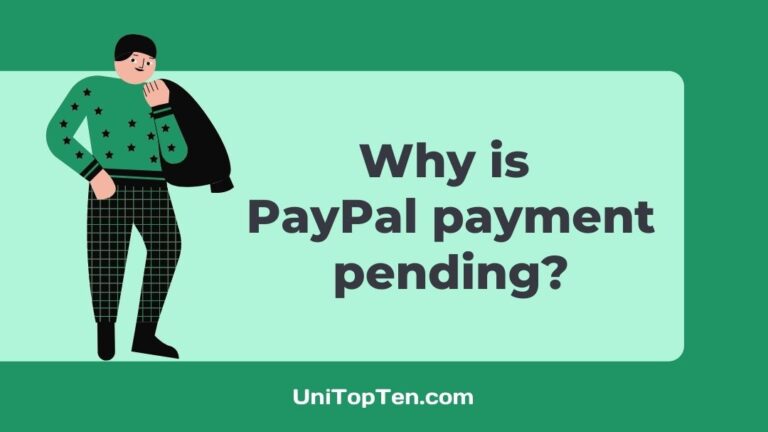PayPal has become a widely used and convenient platform for sending and receiving money online. With its ease of use and widespread acceptance, PayPal has become a popular choice for individuals and businesses alike.
However, one common issue that users may encounter is the status of their outgoing payments being stuck in a “Pending” state.
In this article, we will explore the possible reasons behind this situation and discuss how to resolve it.
What does payment pending mean on PayPal
Paypal pending payment simply means that the payment has been issued by the sender but has not been processed yet. The sender has already initiated and completed the payment on their end, but it still needs to be received by the recipient.
Well, there are many reasons why Paypal payment is pending. And as a sender and recipient, you must know all the possible reasons for the pending payment issues.
In the next part of this post, we have included all the information you must know.

Why is PayPal payment pending (Outgoing payment pending)
Reason 1- Incorrect or Unregistered Email/Phone Number
If the payment was sent to an email address or phone number that is not registered to a verified PayPal account, the payment will remain pending or unclaimed.
It is important to double-check the recipient’s contact information to ensure accuracy.
Reason 2- Recipient’s Payment Preferences
The payment can be pending or unclaimed if the recipient has set up their PayPal account to manually accept certain types of payments.
This could include payments in a different currency or from buyers with unconfirmed addresses.
In such cases, the recipient needs to manually accept or deny the payment within 30 days.
Reason 3 – Account not Verified
If the recipient does not have a PayPal account or has not completed the verification process, the payment will stay pending or unclaimed. The recipient may need to set up a PayPal account and verify it before they can receive the payment.
Reason 4 – New Account
PayPal payments can be pending if the sender has recently created a new account. PayPal imposes restrictions on transferring large sums immediately after account creation to ensure platform security. They may manually review transactions to prevent unethical activity.
Fix: To resolve the issue, PayPal encourages users to establish credibility gradually over time. As you continue using PayPal, transactions involving significant amounts will take time to process smoothly.
Reason 5 – Inactive Account
Having an inactive Paypal account will reduce your credibility if you are a seller. And just like a new seller on the platform, Paypal will hold your payment if you were to make a significant transaction.
Fix – To prevent your payment status from going ‘pending,’ you should keep your transaction history healthy and keep building credibility. If you are a verified user on Paypal and are not planning to switch to other payments platform, you should definitely keep your account active.
ALSO SEE: How to cancel pending payment on Paypal
Reason 6 – Suspicious Activity
PayPal closely monitors its platform for any signs of suspicious activity to maintain the privacy and security of its users.
If there is any unusual or abnormal activity detected in a transaction, PayPal may place the payment in a pending state and contact the account holder for further verification or clarification.
Reason 7 – Selling Riskier Items
There are many other reasons why your payment is still pending. Sometimes, Paypal holds transactions that involve buying and selling expensive items like tickets, gift cards, travel packages, consumer electronics like iPhones, etc.
Fix – Paypal has no restriction for buying and selling expensive items. But, as a seller, you must have credibility to be able to sell expensive items as well.
Reason 8 – Flagged Account
PayPal keeps a close eye on user activities and reviews reports from its community. If your account receives multiple user reports or engages in suspicious behavior, PayPal may flag your account.
While your account remains usable, pending payments may occur as PayPal conducts additional checks to ensure the security and integrity of transactions.
To avoid account flags, it’s important to provide quality products or services to customers without any hidden charges or unsatisfactory experiences.
Reason 9 – Uncleared eChecks
Sometimes, Paypal users pay using echecks. It is a type of electronic fund that simply transfers funds from your bank account to the recipient’s bank account. But, sometimes, you can observe a delay in payment.
First of all, the payment by echecks is not made instantly. You will need to wait till the echeck clears the bank. And according to Paypal, echecks take up to 6 business days to clear the bank. If you are looking for instant payment, echecks might not be a good option.
Fix –If possible, consider using alternative payment methods on PayPal, such as credit or debit cards, for instant payments. If eChecks are the only option, ensure that you correctly write the check and follow all instructions.
Make sure to have sufficient funds in the sender’s bank account to cover the amount mentioned in the eCheck. If there are insufficient funds, the payment will be declined.
ALSO SEE: Fix: Paypal refunded but no money in bank
How to get pending money from Paypal faster
If you are a seller, you can ensure to get the pending money from Paypal faster by printing a USPS or UPS shipping label. And another way is to add tracking information.
By doing this, you are proving your services to be legit, and Paypal will release the pending payment within a few days.
To read more about how to print a USPS or add tracking information, we suggest visiting our dedicated post.
VISIT NOW: How to get money off hold on PayPal
Final Words
In summary, outgoing PayPal payments can be pending due to factors such as new accounts, unverified accounts, suspicious activity, high-value items, or uncleared eChecks.
To fix the issue, be patient, build credibility with a new account, verify your account, respond to PayPal’s requests for information, establish trust as a seller for high-value items, and consider alternative payment methods for faster transactions.
By addressing these factors, you can resolve pending payment concerns and ensure a smoother PayPal experience.
Further Reading:
- How to get money off hold on PayPal
- Why is PayPal payment pending [Fix]
- How to cancel pending payment on Paypal

Ankit Kumar is an Engineer by profession and a blogger by passion. Over the last several years, he has written tons of articles, solving queries on Quora. He also has years of experience in investing in Cryptocurrencies, Funds, and Stocks.
